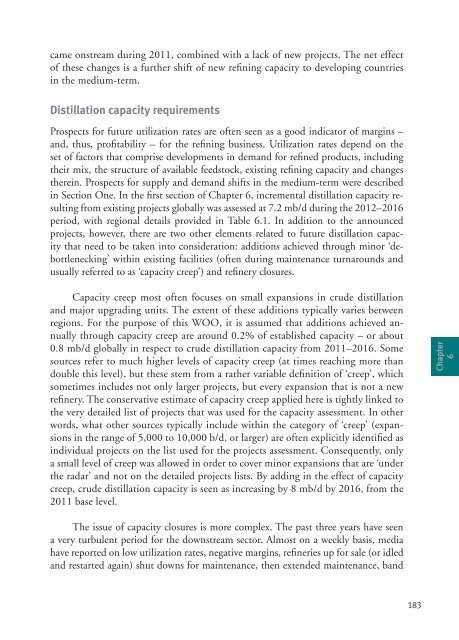World Oil Outlook - Opec
World Oil Outlook - Opec
World Oil Outlook - Opec
- TAGS
- world
- outlook
- opec
- www.opec.org
You also want an ePaper? Increase the reach of your titles
YUMPU automatically turns print PDFs into web optimized ePapers that Google loves.
came onstream during 2011, combined with a lack of new projects. The net effect<br />
of these changes is a further shift of new refining capacity to developing countries<br />
in the medium-term.<br />
Distillation capacity requirements<br />
Prospects for future utilization rates are often seen as a good indicator of margins –<br />
and, thus, profitability – for the refining business. Utilization rates depend on the<br />
set of factors that comprise developments in demand for refined products, including<br />
their mix, the structure of available feedstock, existing refining capacity and changes<br />
therein. Prospects for supply and demand shifts in the medium-term were described<br />
in Section One. In the first section of Chapter 6, incremental distillation capacity resulting<br />
from existing projects globally was assessed at 7.2 mb/d during the 2012–2016<br />
period, with regional details provided in Table 6.1. In addition to the announced<br />
projects, however, there are two other elements related to future distillation capacity<br />
that need to be taken into consideration: additions achieved through minor ‘debottlenecking’<br />
within existing facilities (often during maintenance turnarounds and<br />
usually referred to as ‘capacity creep’) and refinery closures.<br />
Capacity creep most often focuses on small expansions in crude distillation<br />
and major upgrading units. The extent of these additions typically varies between<br />
regions. For the purpose of this WOO, it is assumed that additions achieved annually<br />
through capacity creep are around 0.2% of established capacity – or about<br />
0.8 mb/d globally in respect to crude distillation capacity from 2011–2016. Some<br />
sources refer to much higher levels of capacity creep (at times reaching more than<br />
double this level), but these stem from a rather variable definition of ‘creep’, which<br />
sometimes includes not only larger projects, but every expansion that is not a new<br />
refinery. The conservative estimate of capacity creep applied here is tightly linked to<br />
the very detailed list of projects that was used for the capacity assessment. In other<br />
words, what other sources typically include within the category of ‘creep’ (expansions<br />
in the range of 5,000 to 10,000 b/d, or larger) are often explicitly identified as<br />
individual projects on the list used for the projects assessment. Consequently, only<br />
a small level of creep was allowed in order to cover minor expansions that are ‘under<br />
the radar’ and not on the detailed projects lists. By adding in the effect of capacity<br />
creep, crude distillation capacity is seen as increasing by 8 mb/d by 2016, from the<br />
2011 base level.<br />
The issue of capacity closures is more complex. The past three years have seen<br />
a very turbulent period for the downstream sector. Almost on a weekly basis, media<br />
have reported on low utilization rates, negative margins, refineries up for sale (or idled<br />
and restarted again) shut downs for maintenance, then extended maintenance, band<br />
183<br />
Chapter<br />
6
















